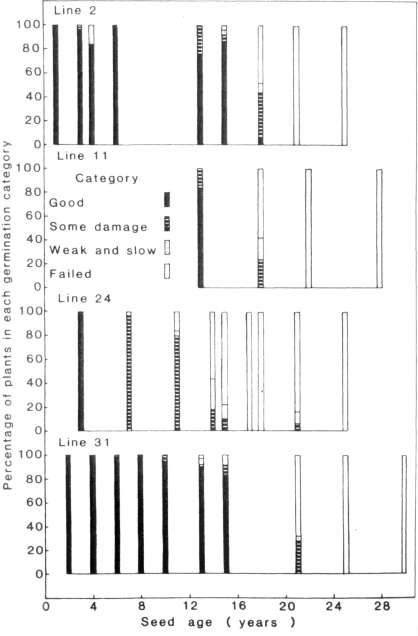LONGEVITY OF PEA SEED IN STORAGE AT HOBART
Murfet, 1. C. and R. Cramp
Department of Plant Science
University of Tasmania, Hobart, Tasmania 7001,
Australia
Seed longevity is influenced by
temperature and humidity during storage (2,4). However, no special
seed storage conditions are used at Hobart and we have recently examined
seed longevity in our system by testing germination in seed samples
of four lines which were among the first incorporated into the Hobart
Pisum collection some thirty years ago.
Lines 2 (Lamm line 2, Rasmusson's
grey dwarf), 11 (Barton Pll), and 31 (Lamm line 31) have round seeds (R)
with anthocyanin present (A). Line 24 (a single plant selection from 1957
stocks of cv. Greenfeast) has wrinkled seed (r) lacking anthocyanin
(a). The seeds have been kept in paper
envelopes in cardboard boxes
stored in the senior author's office. Since 1965 that office has been in a
brick and concrete building heated in winter. Room temperature is
generally in the range 17-22 C. Prior to 1965 the office was in a wooden
hut where temperature variation was more pronounced. Hobart has a
mild, temperate climate (July mean temperature 8 C, humidity 77%; January
mean temperature 17 C, humidity 51%).
Seed samples (n=50) ranging in
age from 1-30 years were sown 2 cm deep in a sterilized peat/sand mixture
and germinated at 17-23 C. Seed coats were knicked to facilitate
imbibition and the seed dusted with Thiram. Seedlings were arbitrarily
assigned to one of three categories (Fig. 1). Plants which were
essentially normal, healthy, and vigorous were assigned to category 1
(good). Seedlings which were still fairly strong but with some signs of damage
due to age, e.g. small pale areas on the Leaves and/or abnormalities in
leaf morphology, were assigned to category 2 (some damage). Small
weak seedlings with slow growth were assigned to category 3 (weak and
slow). Cases where a plumule failed to emerge above the soil were assigned
to category 4 (failed). We emphasise that categories 1-3 are not sharply
delineated but classification in this manner allows a more sensitive
insight into the progressive deterioration of the seed with age. Seedlings
in category 2 appeared to recover with time and assume an essentially
normal appearance above approximately leaf 7. In general, the older seeds germinated
more slowly.
The oldest seeds to produce
viable seedlings were the 21-year-old seeds of lines 24 and 31 (Fig. 1).
Even so, line 24 generally showed a mere rapid deterioration with age than
the other three lines all of which produced a high proportion of good
seedlings from seed aged 13 to 15 years. Whether the more rapid
deterioration of line 24 is related to the recessive condition for genes
r and/or a
cannot be determined from this one
study. Genetic differences in survival can be determined more
rapidly using artificial aging
conditions, e.g. high temperature and humidity. However, from a practical
point of view it is useful to have actual longevity data obtained in
normal conditions. Varietal differences in seed longevity have been
reported for peas (5) and germination after 31 years has been
recorded
With the rise in genebanks and
national collections over the past 20 years conditions for the
preservation and storage of germplasm have generally been upgraded.
Nevertheless, we have found that at least some
